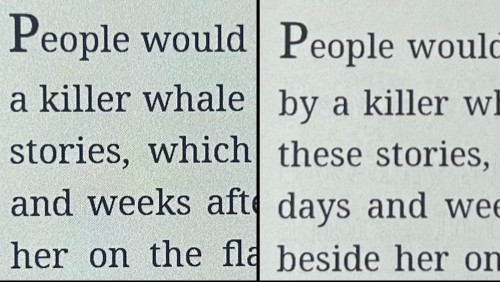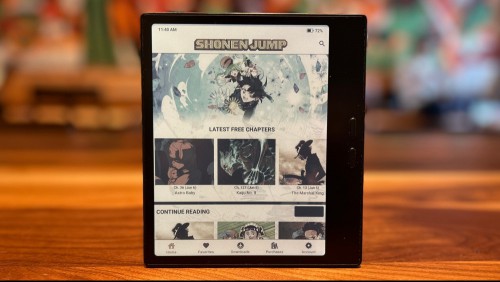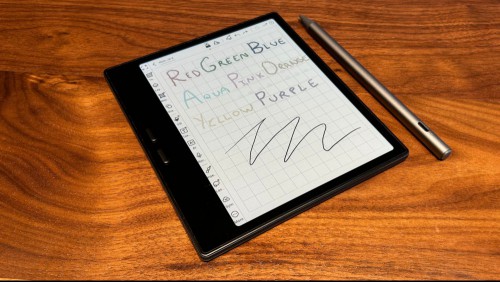If you wanted to buy an e-reader and could choose between two models that were otherwise identical, but one offered a color screen and cost just $20 more, you'd think the decision would be a no-brainer. Why would you choose a monochrome screen when you could read and browse your bookshelves in full color? Well, I have a few reasons.
A few weeks ago I reviewed the new Boox Go 7, a seven-inch black-and-white e-reader from Chinese tech company Onyx International that I called a better version of the best Kindle ever made. It's a fantastic piece of tech, with a crisp screen, tons of onboard storage, and an open Android operating system that allows you to buy your books from any source and install any app on the Google Play store.
At the same time, Onyx also released a nearly identical device—same innards, same physical buttons, same stylus support—but with a color Kaleido 3 e-ink screen. Like the standard Go 7, the Boox Go Color 7 Gen II (confusingly, it's the successor to last year's Boox Go Color 7, but Onyx decided to give it basically the same name) is a best-in-class device, and earns my strong endorsement as the best color e-reader you can buy right now.
But I'd actually urge you to buy the black-and-white version instead, unless you've seriously considered the drawbacks.
Color e-ink isn't there yet
E-reading enthusiasts have been clamoring for color e-ink since the launch of the first Kindle, craving a device that offered all the benefits of the technology—a battery-sipping, low refresh rate screen to ease eyestrain, a glare-free display for use in direct sunlight—but also let you enjoy color content like comics and cookbooks. Late last year, Amazon finally released the Kindle Colorsoft, the first color version of its ubiquitous e-reader, though other companies (including Onyx) had already been experimenting with the tech for years.
But whether from Amazon, Kobo, or Onyx, all color e-ink devices have one thing in common: They use the exact same technology, called Kaleido 3—a color layer sandwiched between the black-and-white display and the outer glass or plastic screen—and it just doesn't look that good. Far from the vibrant hues you'd see on an iPad, color e-ink looks muted, closer to old comics printed on low-quality newsprint than bright images on glossy paper. Kaleido 3 can reproduce just 4,096 colors, versus the millions of an LCD or LED display.
Color e-ink resolution also, frankly, kind of sucks. While black-and-white content will be displayed at 300ppi on a modern Carta 1300 screen (the one used in the Kindle Paperwhite and both models of the Boox Go 7—yes, all e-readers use the same black-and-white screens too), color content maxes out at 150ppi, meaning your comics will look far from sharp and detailed.
Black-and-white content looks worse

Even if you can accept the limitations of color e-ink tech, the real downside is that Kaleido 3 makes all your black-and-white content look noticeably worse. As noted, the "color screen" is actually a color layer placed over a black-and-white screen, and it remains there even if you're reading a book in plain text or a monochrome volume of manga. This creates what e-ink geeks call the "screen door effect"—basically, your black-and-white books will look a little fuzzy and washed out, as if you're looking at them them through a fine mesh screen.

The effect isn't subtle. If I've been reading on a black-and-white device like my Boox Palma, switching to one with a color screen is always jarring—I instantly feel like I have to bump up my font size or mess with my settings to make the text sharper. And even then, the screen will always look noticeably darker, likely requiring you to keep the front light cranked to max unless you're reading in direct sunlight.
Most of what I read is black and white (novels and manga), so for me, this tradeoff is not worth it. For the rare times I want to read in full color, I'd rather just use a traditional tablet.
The Go Color 7 screen looks good, for color e-ink
All of those complaints and caveats aside, as color e-ink goes, the Go Color 7 looks pretty good. All Boox devices have variable refresh rates, which you can set on a per-app basis or change on the fly, to mitigate the "ghosting" (the residual image that lingers after a page turn) that is common to all e-ink screens and typically much worse for color content.
Though it can't compete with the Kindle Colorsoft (which uses a proprietary "color stack") when it comes to color depth and saturation, the Go Color 7 looks just as good as the other color e-ink devices I've tried, the Bigme B751C and the Kobo Libra Colour.
A great open Android device
Existential questions plaguing color e-ink aside, the Go Color 7 is a great little device—and, again, a virtual clone of its black-and-white companion, the Go 7. I've already gone in-depth on the latter, and having switched back and forth for the past several weeks, I can confirm that there are no differences between them in terms of performance, build, or features. (This is a very good thing—the Go 7 is the best all-around black-and-white e-reader I've tried.)
It has the same form factor with an offset side bezel and responsive physical buttons; the same 2.4 gHz Snapdragon 680 octa-core CPU with 4GB of RAM, for speedy performance opening and running your apps; the same 64GB of onboard storage (with a micro SD slot that supports cards up to 2TB). There's a microphone for recording voice notes and a decent external speaker for listening to audio. There's no headphone jack, but there is Bluetooth support to connect devices like earbuds and keyboards.
Unfortunately, this one isn't fully waterproof either, but it will stand up to rain and splashes. Just don't drop it in the tub.
Download any reading app (or any other app) you want
For me, the key selling point for any Boox device over the likes of a Kindle is its open Android operating system, with access to the Google Play store. In addition to giving you the option to customize your experience by installing an alternative launcher, this means you aren't tied to buying books from only one storefront. You can install apps from Kindle, Nook, Kobo, or any other available on Google Play, so you can access your existing e-books library while being choosy about where you shop in the future. While it's true that app performance sometimes isn't quite as good as reading on a dedicated e-ink device for that storefront (page turns may be marginally slower, for example), the difference is insignificant when weighed against that freedom.
If you have a collection of DRM-free e-books, you can also choose to read in the default Neo-Reader app, which is actually pretty excellent, offering a ton of customization options and the ability to add your own favorite fonts.
App access for reading comics and manga

As Lifehacker's Michelle Ehrhardt noted in her review of the Kindle Colorsoft, better color images don't matter much if you can't access your library of comics on the device—and while Kindles can't run any apps, the Go Color 7 can run any apps you want. As far as I'm concerned, Google Play support is an absolute must for any color e-reader, because that means you'll be able to use subscription all-you-can-read apps like Shonen Jump and Marvel Unlimited.
Take notes in color, if you must

While in many ways this second-generation of the Go Color 7 is similar to the previous one (maybe that's why Onyx didn't bother to change the name?), it does add a key feature: stylus support. The stylus is not included with the device; you can get it in a $317 bundle with a leather cover if you order directly from the Boox website (preorder-only as of this writing), or by itself on Amazon for about $50.
As I noted in my review of the Go 7, while support for note-taking and writing in your books (provided your app allows it—Neo-Reader does, but Kindle doesn't) is a nice-to-have, the experience isn't comparable to e-notebooks like Onyx's own Note Air 4C and Note Max, let alone a single-purpose writing device like the Supernote Manta or reMarkable Paper Pro. While the Note series devices use EMR (electromagnetic resonance) styluses that work without batteries or pairing, the Go 7 supports a new kind of pen that Onyx calls Inksense; it charges via USB-C and needs to be paired with the device.
In terms of pure functionality, the Inksense is fine—it offers the standard 4,096 levels of pressure sensitivity for writing lines of different weights, and there is minimal latency while using the device's native Notes app. But I just don't find the experience very pleasant. The Go Color 7's glass screen offers little in the way of tactile resistance, so writing feels a bit unnatural, and I find it makes my handwriting look worse. If you want an e-reader that will double as a notebook, I'd recommend the larger (and, yes, much more expensive) Note Air 4C. (Check out my review of the Note Air 4C for more thoughts on the writing experience and using the Notes app.)
Battery life is disappointing compared to a Kindle
Like all Android-based e-ink readers, the Go Color 7 consumes its battery charge far faster than optimized, single-purpose e-readers like the Kindle or Nook. Where those latter devices can last for a month or more on a single charge, you're likely to be charging your Boox e-reader a lot more often—from every week to every other day or so, especially you read lots of comics, which require more frequent full screen refreshes to combat ghosting.
If you must have a color e-reader, this is the one to get
I started this review by telling you why I don't think you should buy the Boox Go Color 7, but if you read all that and you still think you're willing to give color e-ink a go, this one is definitely my choice for the best option on the market. Though the Kindle Colorsoft offers slightly better image quality, the Go Color 7's open Android operating system easily trumps it by giving you the option to read from anywhere.
I hope that color e-ink will continue to improve to the point that I can enjoy the upsides without being frustrated by the downsides. If you don't want to wait that long, though, I don't imagine you'll be disappointed by this excellent device.
Covering e-readers, social media, entertainment, and more.
